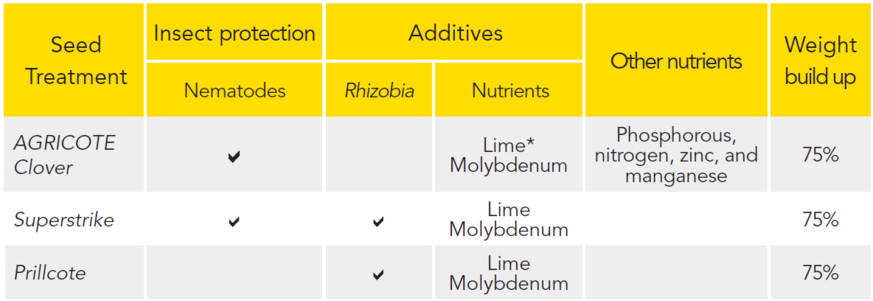Seed treatment
- Seed treatment technology allows a coating to be applied to seeds before sowing.
- It is designed to reduce the risk of losing new pasture or crop at establishment.
- Barenbrug markets four AGRICOTE seed treatments for grass, clover, and brassicas.
Importance of seed treatment
By protecting newly-emerged seedlings from pests and disease, seed treatment insures against paddock failure. Such losses can be $3350/ha or more. Seed treatments can also reduce the need for spraying.
Grass seed treatments

Clover seed treatments

Brassica seed treatments

What is seed treatment?
Seed treatment is the process of treating individual grass, clover, brassica or beet seeds with a mix of fungicides and insecticides (and sometimes nutrients) to protect and enhance establishment.
How does it work?
AGRICOTE treatments contain enough insecticide and fungicide to last approximately 6 weeks post-sowing, the time that young plants are most vulnerable to insect attack and disease. The active ingredients are systemic. As well as protecting the seed itself, they ‘grow’ through the seedling as it emerges. Grass seedlings are not protected by their endophyte until approximately 6 weeks after sowing. So plants rely on seed treatment for protection during that time.

Use seed treatment in a programme
Seed treatment is proven technology, but is not a silver bullet. It gives good control of low to moderate insect pressure. Where insect populations are likely to be high, a wider control programme is needed.
Grass-to-grass renewal
In grass-to-grass (or cereal to grass) pasture renewal via spray-drilling, Argentine stem weevil (ASW) can be present in very high numbers. Generally, we advise adding an insecticide when spraying out the paddock to reduce the ASW population. Then use AGRICOTE Grass to protect establishing seedlings from surviving and newly hatching ASW.
Brassica crops
Insect pests like springtails can be present in huge numbers, many thousands per square metre. Seed treatment will kill springtails nipping seedlings, but by the time many springtails have each nipped a seedling, the crop will be seriously damaged. Monitor newly sown brassica crops daily for the first 14 days, and use an appropriate insecticide if pest pressure is high.
Slugs in direct-drilling
Seed treatments provide no protection for slugs, which can be a major problem in new pastures, particularly where they are direct-drilled. Monitor paddock for slugs, and bait as necessary
A Stewardship Guide for handling and sowing treated seed is available at www.agcarm.co.nz

